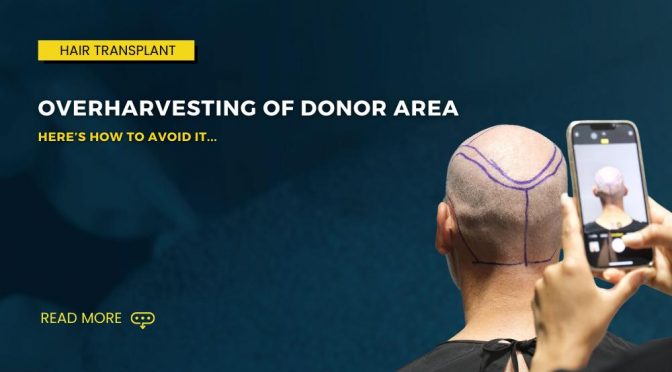-
Languages ENGLISH
-
Call 24/7 +39 030 764 1043
-
Open Hours Mon - Sat: 9am to 6pm

Hair transplant surgery has evolved tremendously over the years. Despite this, one aspect that remains critical is the management of the donor area – the region from which hair follicles are extracted for transplantation. Mismanagement of this area, particularly in the form of overharvesting, can lead to unfavourable results.
Overharvesting refers to the excessive extraction of hair follicles from a specific region of the scalp, usually the back of the head or the sides, known as the donor area. This practice can lead to irreversible damage, compromising both the aesthetic results and future hair transplant possibilities.
The donor area is typically a region of the scalp that is resistant to hair loss, ensuring the transplanted hair follicles will not thin or fall out after the procedure. The back of the head is commonly chosen as it generally has a high concentration of healthy hair follicles. However, in some cases where this area is not suitable, alternative donor areas like the beard or body hair can be considered.
Preservation of the donor area is vital in hair transplantation. The number of available healthy hair follicles in the donor area largely determines the potential success of the procedure. Additionally, preserving the donor area also allows for future hair transplant surgeries, should there be a need.
Overharvesting the donor area can lead to various detrimental effects:
Excessive extraction of hair follicles can lead to visible scarring and patchy hair growth. This not only disrupts the natural aesthetics of the hair but can also lead to permanent damage, limiting hair growth in the overharvested area.
Overharvesting reduces the available hair follicles for subsequent hair transplants. Consequently, patients who may require additional procedures might find this impossible due to an inadequate number of follicles in the donor area.
Overharvesting can also result in additional hair shedding, a condition known as Postoperative Effluvium. This additional hair loss is usually temporary, lasting a few weeks, but it can cause distress to the patient during the recovery period.
Preventing overharvesting should be at the forefront of every hair transplant procedure. Here are some strategies to ensure the donor area is adequately preserved:
Choosing a reputable clinic like BlueMagic Group Clinic can significantly reduce the risk of overharvesting. These clinics boast experienced surgeons who understand the importance of preserving the donor area and are skilled in extracting the right amount of harvested grafts. In this video you can see, how professionals ensure the preservation of the donor area during and after the hair transplant surgery.
Adopting a hair loss prevention treatment plan can slow or even stop further hair loss. When hair loss is under control, the impact of overharvesting on the overall results could be reduced.
It’s crucial to discuss the possibility of future transplants with your consultant and surgeon. This way, they can take extra care to protect the follicles in your donor area and only extract what is necessary.
While hair transplants offer a viable solution to hair loss, overharvesting the donor area for the hair transplant could lead to irreversible consequences. Therefore, it’s paramount to consult with experienced professionals who can guide you through the process while preserving your donor area. Different hair loss situations, make essential the initial medical consultation, in which the donor area is carefully evaluated among everything else, to provide a sustainable hair loss solution through the hair transplant procedure.
Remember, your hair is precious, and so is your donor area. Treat it with the respect it deserves.
Smart Choices for Hair Restoration: Why FUT Hair Transplant May Not Make the Cut
Curious to know how your hair transplant would go? Connect with us today and let us help you understand each and everything with the help of the experts. & let us give you complete details with the help of a free consultation.
 Get free consultation
Get free consultation
Kindly fill up this form and we will get back to you at the earliest.